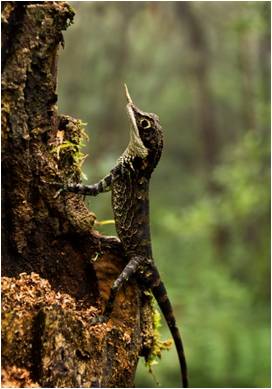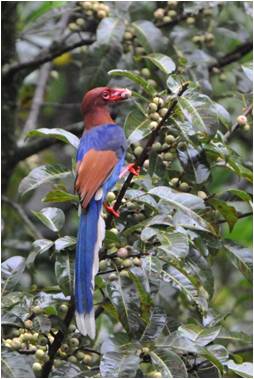EPISODE 15 – Horton Plain National Park

Foreseeing the Risk
I worked at Horton Plains National Park from 2004-2005 and until the end of 2009-2002. Horton Plains is the largest tourist attraction in Sri Lanka. A large number of local and foreign tourists visit this park every year. From 2009-2012, I worked as a gardener there. We had a staff of about 25 members. We stayed in the park quarters. As wildlife officers, we are on duty 24 hours a day.
Most people love to see the World’s End in Horton Plains Park. Worlds End is located in the jungle trek. You have to go about 7 km on that jungle trek to reach the Worlds End. There are a number of places to visit along this route. Little World’s End, Chimney Ponds, and Bakers Falls are among them. The second and third highest mountains in Sri Lanka, Kirigalpotta and Thotupola Kanda, are located in the Horton Plains Park. School children, cadets, photographers and environmentalists are also come to climb the mountain. As the Horton Plains function as a catchment area, ponds and streams are ubiquitous. The tributaries of the Mahaweli, Kelani and Walawe also originate from here. BelihuloOya originates from Bakers Falls and Agra Oya flows from Dayagama side.
Tourists visiting Horton Plains are fascinated by this beauty. Although the environment is beautiful, there are many dangerous places as well. Tourists forget the risk.
One day, an Australian foreigner went to photograph a beautiful lizard in the Horton Plains at the Worlds End. He came with his wife. He went backwards and fell down from the Worlds End. We worked hard with the police and the locals to find the body. The body was found in an area called Periyalwatta below the world’s end.
Another day a group of local tourists came. Among them was a cute boy. This kid has been trying to bathe everywhere. Just as he approached the waterfall, he suddenly jumped into the water. Bakers Falls is freezing cold. Bathing is not allowed. Two children came running crying, saying that a younger brother had drowned. We informed the police and searched for the child. But we could not find him. Later a group from the Navy came and found the body.
When traveling, travel with responsibility and understanding. Then accidents like this can be avoided.
I want to say one more thing. Young groups of tourists pick flowers and plants. These flowering plants do not grow in any other environment. We need to protect them. Horton Plains should be kept beautiful.
Mr. G. U. Saranga

Mr. G. U. Saranga joined the Wildlife Department in 1983 as a Ranger and he was fortunate to work in various National Parks and Sanctuaries. He received his basic training at the Yala and Wilpattu Sanctuaries. He was in charge of the Sigiriya Sanctuary and later worked at the Minneriya National Park and then at the Wasgamuwa National Park for seven years. He also served as Park Warden at Horton Plains National Park from 2004-2005 and 2009-2002. Mr. Saranga was later promoted to Assistant Director and was in charge of the Kilinochchi area and later the Ampara area. He is currently in charge of the Vavuniya region.
Mr. Saranga completed a 9-month Diploma course awarded by the Department of Wildlife in 1995 and trained for three months at the Wildlife Institute in Dehradun, India. He has also completed short training courses in countries such as Korea, the Philippines and Thailand.
Mr. Saranga’s house is located in Katugastota, Kandy.
Horton Plain National Park
After a train ride through the tunnels through the mountains, you can enjoy the beauty of the range of quiet tea plantations in the distance through a train window, we have now reached Horton Plains, a beautiful place in Sri Lanka that has attracted the attention of locals and foreigners alike.
This is a unique National Park with a rich biodiversity as well as archaeological value. Horton Plains, the only national park in the wetlands of Sri Lanka, was originally known as MahaEliya and is the highest mountainous plain in Sri Lanka. Situated in the central highlands at an altitude of 2100-2300 m above sea level, this is a beautiful area spread over an area of 3.169 hectares. Captain William Fisher and Colonel Albert Watson, both Englishmen of the 1920s, are credited with officially discovering Horton Plains. The forest was declared as a Nature Reserve on 05thDecember, 1969 and was declared a National Park on 16thMarch, 1988 due to its location value, which is located on the border of Samanala Kanda. In July 2010, it was added to the World Heritage List.

Horton Plains is a beautiful place located in the NuwaraEliya District of the Central Province. This area is located in the central highlands between NuwaraEliya and Haputale and receives Southwest and Northeast and inter monsoon rains. The average annual rainfall of the MahaEliya is more than 2500 mm and the area receives an average amount of rainfall throughout the year but there is a severe dry season from January to March. The average temperature in the Horton Plains area is around 13 degrees Celsius, with occasional drops to 5 degrees Celsius at night with a mild morning frost occurring from December to February.
The main mountain range is Horton Plateau, the highest plateau in Sri Lanka, at an elevation of 2357 m above sea level and the adjoining Kirigalpottha Mountain situated at an elevation of 2389 m. Horton Plains is the coldest and windiest place in Sri Lanka and you can also observe the stunted vegetation due to the high winds blowing through this area. It consists of mountainous evergreen forests, grasslands, swamps and aquatic ecosystems, covering an area of about 7,000 acres. It can be seen that about 4,000 acres of lush grown grasslands. It is one of the most important catchment areas in Sri Lanka and supplies water to the Mahaweli, Kelani and Walawe rivers as well as BelihuloOya, KiriketiOya, Uma Oya and BogawanthalawaOya.
According to research conducted in 1992, there are about 101 species of plants here. 49 of them are endemic to Sri Lanka. What is special is that most of them are endemic to Horton Plains.Rhododendron (Rhododendron arboreum), a beautiful red flower, is a popular plant among local and foreign tourists. Maharatmala(Rhododendron) is symbolic Central Province flower and Rhododendron is usually found in this environment from April to July. Ratu mihiriya (Adinandra lasiopetala), Kina (Calophylem walkeri), wal kurudu (Cinnamomum ovalifolium), wal sapu (Michelia nilagirica) and Binara (Exacum trinerva macranthum) are other flowering plants found here.


98 endemic species of birds, 14 species of mammals, 16-20 species of amphibians and 40 species of butterflies have been identified in the Horton Plains Ecosystem as at now. Sambar (Cervus unicolor) is the most populous of the four-limbed animals. In addition, Fishing Cat (Prionailurus viverrinus), Barking Deer (Muntiacus muntijak), Giant Squirrel (Ratufa macroura), Leopard (Panthera pardus kotiya), Indian hare (Lepus nigricollis), Wild Boar (Sus scrofa), Porcupine (Hystrix indica) Mammals such as Eurasian otter (Lutra lutra ceylonica), Gray Slender Loris (loris lydekkerrianus), and Purple-faced langur (Semnopithecus vetulus monticola) can be found in this ecosystem.Amphibians include Leaf-nesting shrub frog (Pseudophilautus femoralis), Sri Lanka frog (Fejervarya greeni), Sri Lanka Narrow-mouthed Frog (Microhyla zeylanica), Rhino horned lizard (Ceratophora stoddartii) as well as a variety of butterfly or reptile species are also found here. Large mammals are rarely seen in the Horton Plains.


Horton Plains National Park is home to about 12 endemic bird species and the following birds are recorded for the Horton Plains only. Sri Lanka blue magpie (Urocissa ornata), dusky blue flycatcher (Eumyias sordidus), Sri Lanka white (Zosterops ceylonensis) and Sri Lanka wood pigeon (Columba torringtoniae), Sri Lanka Spurfowl (Galloperdix bicalcarata), Sri Lanka Jungle flow (Gallus latay), Sri Lanka Whistling Thrush (Myophonus blighi), Sri Lanka Yellow-eared Balbul (Pycnonotus penicillatus) and Sri Lanka Warbler (Elaphrornis palliseri) are some of the birds that can be seen in this park and this is also a butterfly paradise.


NuwaraEliya is one of the favorite places to visit when you have a break from work. Not only the pleasant climate but also many marvelous tourism places are located in the vicinity of NuwaraEliya. Horton Plains is one of the attractive destinations among local and foreign tourists. It is also rich in biodiversity and is a valuable area for those engaged in education and research.
Horton Plains, a wet zone evergreen forest, is a scenic place covered with evergreen peaks and constant mist. Located at the southern end of the Horton Plains Park, Worlds End is a beautiful place, preceded by a small Worlds End and the scenic Bakers Falls which is fed by marvelous Belihuloya have become favourite destination among local and foreign tourists as well.
There are three access roads to Horton Plains, the main of which is viaNuwaraEliya, Ambewela and Pattipola (32 km). You can also reach Horton Plains via the Haputale – Welimada, Boralanda, Ohia (38 km) route and along the road that passes through NuwaraEliya, Haggala, Rendapola, Ambewela, Pattipola (38 km).Horton Plains has several lodges that are managed by the Department of Wildlife Conservation. The renovated Ginihiriya (Anderson) and Mahaeliya houses as well as three campgrounds have been set up for eco-lovers to relax in their natural environment. The lodge, which is reserved for groups of up to 50 people, is located in a beautiful setting with scenic views. These lodges and campsites can be booked at the Head Office of the Department of Wildlife Conservation, Battaramulla, Colombo.
It was named a World Heritage Site, a nature reserve and a park because of its valuable, unique ecosystem. Therefore, it should be the responsibility of all of us to protect the Horton Plains ecosystem.
List of animals in the Horton Plains National Park
Sinhala Name | Tamil Name | English Name | Scientific name |
ගෝනා | மரை | Sambar | Rusa unicolor |
හඳුන් දිවියා | மீன்பிடிப் பூனை | Fishing Cat | Prionailurus viverrinus |
| වැලි මුවා | குரைக்கும் மான் | Barking Deer | Barking Deer |
වල් ඌරා | காட்டுப் பன்றி | Wild Boar | Sus scrofa |
කොටියා | புலி | Leopard | Panthera pardus kotiya |
හාවා | இந்திகுழி முயல் | Indian hare | Lepus nigricollis |
ඉත්තෑවා | முள்ளம்பன்றி | Porcupine | Hystrix indica |
දඬු ලේනා | பழுப்பு மலை அணில் | Giant squirrel | Ratufa macroura |
| දියබල්ලා | நீர் நாய் | Eurasian otter | Lutra lutra ceylonica |
| උණහපුලුවා | சிவப்பு மெல்லிய லொரிஸ் | Gray Slender Loris | loris lydekkerrianus |
| වලස් වඳුරා (කළු වඳුරා) | ஊதா முக இலங்கை குரங்கு | Purple-faced langur | Semnopithecus vetulus monticola |
| පළා පදුරු මැඩියා | இலை கூடு புதர் தவளை | Leaf-nesting shrub frog | Pseudophilautus femoralis |
| ලංකා කඳුකර මැඩියා | இலங்கை தவளைவாயன் | Srilanka frog | Fejervarya greeni |
ලංකා මුව පටු මැඩියා | இலங்கையின் குறுகிய வாய் கொண்ட தவளை | Sri Lanka Narrow-mouth Frog | Microhyla zeylanica |
| අං කටුස්සා | காண்டா மிருகக் கொம்புப் பல்லி | Rhino horned lizard | Ceratophora stoddartii |
වලි කුකුළා | இலங்கைக் காட்டுக் கோழி | Sri lanka junglefowl | Gallus lafayettii |
| ශ්රී ලංකා කැහිබෙල්ලා | இலங்கை நீலச் செவ்வலகன் | Sri Lanka blue magpie | Urocissa ornata |
ශ්රී ලංකා අනු මැසිමාරා | வெளிர் நீல ஈப்பிடிப்பான் | Dusky blue flycatcher | Eumyias sordidus |
| ශ්රී ලංකා අනු මැසිමාරා | வெளிர் நீல ஈப்பிடிப்பான் | Dusky blue flycatcher | Eumyias sordidus |
| මයිල ගොයා | இலங்கை மரப் புறா | Sri Lanka wood pigeon | Columba torringtoniae |
හබන් කුකුළා | சின்னக் காட்டுக்கோழி | srilankaSpurfowl | Galloperdix bicalcarata |
ශ්රී ලංකා අරංගයා | இலங்கை விசில் த்ரஷ் | Sri Lanka Whistling Thrush | Myophonus blighi |
ශ්රී ලංකා පීතකන් කොණ්ඩයා | மஞ்சள் காது புல்புல் | Sri Lanka Yellow-eared Balbul | Pycnonotus penicillatus |
ශ්රී ලංකා වන රැවියා | இலங்கை புஷ் போர்ப்லர் | Sri Lanka Warbler | Elaphrornis palliseri |
List of trees in the Horton Plains National Park
Sinhala Names | Tamil Names | English Names | Botanical Name |
මහරත්මල් | மகா ரத்மல் | Rhododendron | Rhododendron arboreum |
රතු මිහිරිය | ரது மிஹிரிய | Ratumihiriya | Adinandra lasiopetala |
කින | கின | Kina | Calophylem walkeri |
වල් කුරුදු | வல் குருந்து | walkurudu | Cinnamomum ovalifolium |
වල් සපු | வல் சபு | walsapu | Michelia nilagirica |
බිනර | பினர | Binara | Exacum trinerva macranthum |
Editor– Dammika Malsinghe, Additional Secretary,Ministry of Wildlife and Forest Conservation (MWFRC)
Article on park written by– Hasini Sarathchandra, Chief Media Officer, Department of Wildlife Coservation (DWLC) Mahesha Chathurani Perera (Graduate Trainee), (DWLC)
Tamil Translations– A.R.F. Rifna, Development Officer, MWFRC
English Translations – Asoka Palihawadana, Translator, MWFRC
Web Designing–N.I.Gayathri, Development Officer,MWFC-C.A.D.D.A. Kollure, Management Service Officer, MWFRC
Photography– Rohitha Gunawardana, DWLC